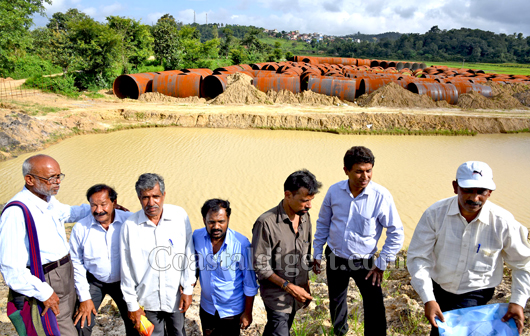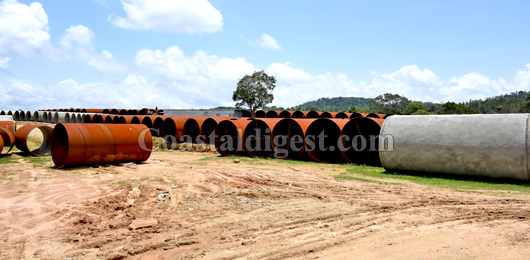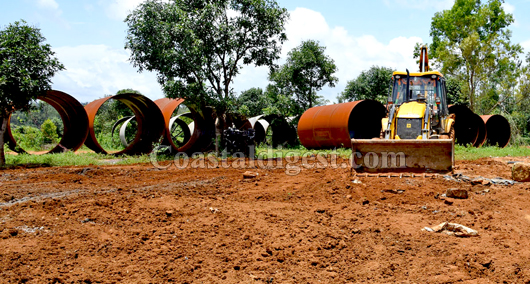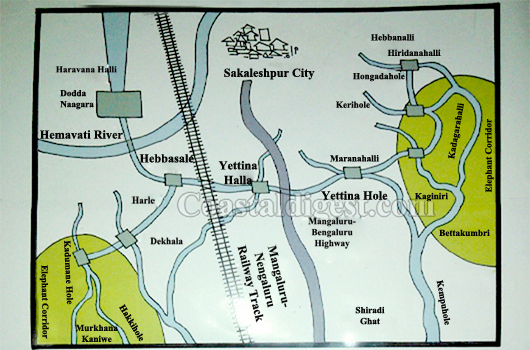From bypassing crucial environmental clearances to illegal logging of trees and major construction works in identified elephant corridors in Sakleshpur taluk in Hassan district, the Yettinahole river diversion project has allegedly flouted innumerable laws and policies during its implementation.

Renamed as Yettinahole Integrated Drinking Water Project at present, it originally proposed acquisition of nearly 190 hectares of land for the entire project, including 20 hectares of forest land.
Although the detailed project report states diverting a total of 24 TMC of water towards parched districts in the state, a recent study by a team of experts from the Centre of Ecological Sciences (CES) in the Indian Institute of Science (IISc), Bengaluru led by Prof T V Ramachandran revealed that only about 9 TMC of water was available at the source. However, the authorities concerned have overlooked this study and went ahead with the project.
Insufficient water in the rivulets
A look at the ongoing construction at a check-dam at Yettinahalla merely 50 metres away on the Bengaluru-Mangaluru national highway close to Sakleshpur town, reveals hardly two feet of water flowing in the rivulet due to inadequate rainfall in the region during monsoons this year.
A group of activists led by H A Kishore Kumar, president of Malenadu Janapara Horata Samiti, told reporters during an interaction in Sakleshpur, that it was the same case in Hongadahole, Kerihole, Yettinahole, Hebbasale, Kadumane and other locations where check-dams have been proposed for the project. There is not enough water in the several rivulets originating from this taluk as it was expected. This will also mean that there will be insufficient water during the summer months in the Kumaradhara river which joins the Nethravathi downstream, he said, stating that the state government was not concerned about the farmers who depended on this water in Hassan and Dakshina Kannada districts.
Illegal felling of trees
Local agriculturists and green activists from Sakleshpur taluk allege that not only was there no acquisition of land in the taluk for the project, but trees have been illegally felled by the contractors undertaking the project.
Environmentalist Dinesh Holla, who is also the convenor of Sahyadri Samrakshana Sanchaya, said that the several trees were felled for construction of roads in places such as Sakleshpur, Kumbaradi, Hebbasale and Yettinahalla without the permission of the forest department. “This is a gross violation of Karnataka Preservation of Trees Act. Nearly 500 trees may have been felled to construct the check-dam at Yettinahalla, with any permission. In total, around 400 acres of rich agricultural land in Sakleshpur taluk will be damaged by the project,” he said.
He also said that the forest department had filed three cases against contractors for felling trees on private land in order to construct a check-dam at Yettinahalla.
Meanwhile, Minister for Forest and Environment B Ramanath Rai has maintained that no trees had been felled so far during the commencement of this project. “The work that is being done is preliminary work and there is no contravention of any provisions of the law at present,” he told reporters after an interaction with the KCCI members in Mangaluru a week ago.
Threat to identified elephant corridors
In addition to the illegal felling, Mr Holla said that two identified elephant corridors in the taluk would be affected by the construction of check-dams in Kadumane and Kadagarahalli areas inside the corridor areas. This defeats the very purpose of establishing elephant corridors to reduce man-animal conflict. This will also affect the vast biodiversity present in the Western Ghats, he said.
Risk to National Highway 75 in Shiradi Ghat
Mr Holla also pointed out the proximity of the National Highway 75 from the check-dam at Yettinahalla set up just metres away. The vast amount of water collected in the check-dam once it is completed, may prove dangerous to the highway as it can trigger landslides during peak monsoons from the next year. Hence, it is risky to construct such a dam in close proximity of the highway, he said.
Manufacturing pipes on fertile agricultural land
Along with the ongoing construction of check-dams, a visit to the interiors of Sakleshpur taluk revealed large pipe fabrication units and stockyards set up by contractors on agricultural lands where massive pipes of 16 feet in length each had been stocked.
There is one such stockyard on a 20-acre land in Satthigala village in the taluk which, according to locals, had been leased to contractors for a period of two years. In a grave violation of revenue laws, similar stockyards have been set up in Hebbasale and Hebbanahalli on fertile agricultural lands without seeking temporary conversion of private land by the district authorities, allege local activists.
Huge trenches dug for massive pipes
Mr Holla said that four major pipes would be laid alongside each other to pump water from the eight check-dams to a huge reservoir at Doddanagara on the banks of Hemavathi river, from where it will be pumped through two massive pipelines to Haravanahalli and then to Devarayanadurga lake in Tumkur.
Deep trenches have been already dug in Hebbasale and Kadumane to accommodate the pipelines, and additional trenches will be required for the other pipelines. Once the pipelines are laid, the fertile land will be mostly rendered useless for agricultural activities, say local farmers.
Circumventing crucial environmental clearances
Mr Kishore Kumar said that by touting the river diversion project as adrinking water' project to supply water to the parched districts such as Kolar and Chikkaballapur, the Karnataka Neeravari Nigam Limited has circumvented crucial environmental clearances from the Ministry of Environment and Forests (MoEF) as the project comes under the purview of EIA notification, 2006.
In reality, the water is planned to be allocated for rejuvenation of lakes and minor irrigation tanks, industries and urban supply. The environmental clearances which are required for such projects are not necessary for drinking water projects, hence this has been deliberately labeled asdrinking water' project, he said.
It is illegal to set up manufacturing units for non-agricultural purposes without conversion of agricultural land.
No public hearing, Environment Impact Assessment (EIA)
Despite widespread public opposition to the Yettinahole Integrated Drinking Water Project, the state government has taken up the project implementation without conducting a public hearing in Hassan and Dakshina Kannada districts. Neither did the government show indication of conducting an Environment Impact Assessment (EIA) on the project that usually accompanies projects to predict the environmental consequences through the proposed action.
A local agriculturist from Hebbasale told reporters that prior to the implementation of the project, there had been no gazette notification on the proposed river diversion scheme. Even till date, there has been no acquisition of land or public hearing in Sakleshpur taluk by concerned authorities. No information was officially furbished by the district authorities and the villagers have been kept in the dark about the entire scheme, he said, claiming that the concerned gram panchayats and the government was hand in glove with each other over the project.
Waste of public money; keeping public in the dark
With the cost of the entire project purportedly to be Rs 13,000 crore at present, it will be a gross misuse of public money by the state government to implement an unscientific project, allege activists.
Meanwhile, sources claim that the Shiradi Ghat stretch of the Bengaluru-Mangaluru highway had been closed for a period of six months to begin work on the Yettinahole project without the knowledge of people. It is clear that the construction completed so far was done in a matter of four months, said Mr Dinesh Holla.
People are also unaware of how much forest and private land will be submerged once the eight check-dams and a reservoir are completed.
Adverse effect of biodiversity in Western Ghats
Mr Kumar also told reporters that the Western Ghats was one of the 12 biodiversity hotspots in the world and home to several endangered and endemic species. The Pushpagiri Wildlife Sanctuary which is recognized as a UNESCO World Heritage Centre is not too far from the project site. It is home to rare and endangered birdlife and is designated as one of the important bird areas of the world. The entire project will cause severe damage to the dense forests in the Western Ghats and adversely affect the ecology it sustains, he said.
At present, a PIL has been filed before the National Green Tribunal seeking a stay on the project on the grounds that it had circumvented necessary environmental clearances.

































Comments
Add new comment